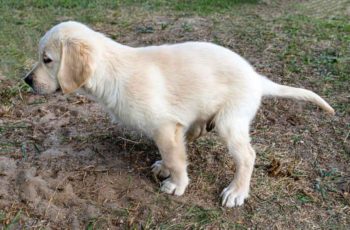This post may contain affiliate links. We may earn money or products from the companies mentioned in this post.
Did you recently adopt a lovable mutt and are now wondering how to socialize a rescue dog?
After all, socialization for rescue dogs is incredibly important as it helps them adjust to their new homes, and builds confidence.
Unfortunately, many rescue dogs have experienced trauma, neglect, or limited socialization in their past, which can lead to fear, anxiety, and behavioral issues.
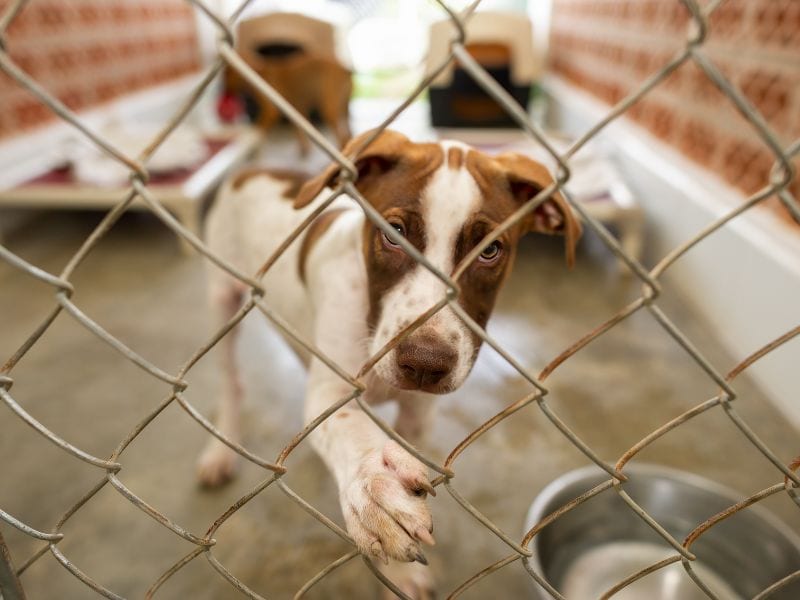
I experienced this first hand with my pup Wally, a 38 lb Feist mix, whom I adopted in 2019 from a rescue group in Central NC.
He had no trouble with people but wasn’t crazy about passing other dogs on leash.
Back in my professional dog walking days, several of my clients also adopted rescue dogs or were fostering them, so I’ve seen a few behavioral quirks over the years.
Unfortunately, that includes one rescue story gone wrong which resulted in having to put the pup down.
So in this blog post, I’m going to share tips and techniques for how to socialize a rescue dog.
I’ll also explain what went wrong in the socialization process of the rescue dog that didn’t make it.
Ready? Let’s jump right in!
How To Socialize A Rescue Dog
Key points for this ultimate guide:
- Understanding Your Rescue Dog – My Rescue Dog Wally As An Example
- Key Elements To Help Socialize A Rescue Dog
- Crate Training And Designated Areas For Socializing Rescue Dogs
- Establishing A Routine And Providing Consistent Boundaries For Your Rescue Dog
- Gradually Exposing Your Rescue Dog to New Environments
- Positive Reinforcement Training To Help Socialize A Rescue Dog
- Basic Obedience Training & Key Commands For Rescue Dogs
- Why Positive Social Interactions Are Important For Your Rescue Dog
- Examples Of Activities To Help Socialize Your Rescue Dog
- A Rescue Story Gone Wrong
Understanding Your Rescue Dog – My Rescue Dog Wally As An Example
Rescue dogs often face unique challenges due to their backgrounds, which can vary widely depending on their individual experiences.
Wally, for example, had been pulled from a kill-shelter in rural NC by a rescue organization called It takes A Village Rescue. They pulled him when he was a little over one year old.
Before he was surrendered at the shelter, he had already been to 2 different homes, and that’s within the first year of his life!
I suspect that four distinct factors contributed to his surrender:
(1) His energy levels. As a squirrel hunting dog, this boy needs long walks every single day, and I found that backpack walks are ideal to help burn all of his energy.
He’s definitely not the kind of dog that can just hang out in the yard.
He NEEDS multiple daily walks.
(2) His food allergies. When he came into my life, Wally was one itchy pup who kept scratching, and scratching, and scratching.
After some trial and error that included taking a pet allergy test, I found out that he can’t have any chicken, quail, salmon, anchovies, potatoes and also no grains along with several veggies.
And go figure, the kibble he came to me with had chicken and potatoes on the ingredient list, so it was no wonder he was so miserable.
Since he’s allergic to many common dog food ingredients, that reduced his food choices considerably.
That’s why I went ahead and switched him from kibble to raw dog food and he’s been doing great ever since.
(3) His love for shredding things. Mostly plush toys, but unfortunately not just plush dog toys, but also plush kids toys.
He also likes “kidnapping” them from shelves in pet retail stores!
I started working on this with him and he’ll now let go of them in exchange for a tasty treat, but ultimately, he still wants to rip them apart.
(4) His lunging at other dogs we pass on leashed walks. He does fine with dogs off leash and has several doggie friends he plays with in the yard.
I’ve also been working on this with him and we’ve made progress as far as the distance that sets him off, but it’s still a work in progress.
Keeping all these challenges in mind, I’ve taken several approaches to fixing them. As I just laid out, some were easier and quicker to fix than others.
All in all, it took me about 3 months to find out about all of his quirks, which is the same time he needed to truly feel at home with me.
When you think about it from his perspective, that’s completely understandable.
He must have been wondering whether I’d be taking him somewhere else yet again since that’s all he had experienced up to that point in life.
Now, 4 years later and while I’m typing this, Wally’s lounging in his dog kennel, snoozing away happily after our one hour midday walk.
That’s the second one hour walk he gets every day, the first one being his pre-breakfast morning walk.

Rescue pup Wally relaxing in his crate
What To Expect From Your Rescue Dog
Obviously, every rescue dog has a unique history and will have different quirks and triggers.
Some may be similar to Wally’s, and some may be different.
That said, I listed several examples of what you may expect from your rescue dog:
1. Fear and Anxiety
Many rescue dogs have experienced trauma, abuse, or neglect in their past.
As a result, they may exhibit fear and anxiety in new situations, around unfamiliar people, or when they’re exposed to certain stimuli.
The following are common body postures in fearful dogs:
- Cowering
- Trembling
- Tucked tail
- Tense body
- Ears pinned back
- Lip licking and excessive yawning
- Wide eyes with the white of their eyes showing
2. Lack of Socialization
Rescue dogs may not have had proper socialization during the first 4 months of their lives, which is a formative, critical phase for puppies.
This can result in difficulties in interacting with other dogs, animals, or humans.
They may be fearful, exhibit reactive behavior, or struggle with appropriate social cues.
I suspect that Wally wasn’t properly socialized to other dogs when he was a puppy, which could explain his reaction to other (mostly leashed) dogs we encounter on our walks.
3. Trust Issues
Building trust with a rescue dog can be a significant challenge.
They may have experienced broken trust in the past, making it difficult for them to form new attachments and bonds.
Know that it takes time, patience, and consistent positive experiences to earn their trust.
But your rescue pup may also surprise you – given how many times Wally was passed around during just one year, I was very surprised at how fast he trusted me!
4. Behavioral Issues
Rescue dogs may display a range of behavioral issues, including:
- Separation anxiety
- Resource guarding
- Leash reactivity
- Aggression
These behaviors may have developed as coping mechanisms in their previous circumstances.
5. Adjustment to New Environments
Moving from a shelter or foster home to a permanent home can be a significant transition for rescue dogs.
They need time to acclimate to new surroundings, routines, and household rules.
On average, you can expect the transition period to last about 3 months.
Key Elements To Help Socialize A Rescue Dog
That’s why patience and positive reinforcement are essential elements when you’re helping a rescue dog settle into their new home and trust you.
Here’s why they’re so important:
1. Patience
You may already know that patience is important in dog training as some dogs learn slower than others.
On that note, I remember teaching my late pup Missy the rollover trick. It took her FOREVER and I was on the verge of giving up when she finally rolled over after practicing for 6+ months!
That said, patience is also crucial when you’re working on socializing your rescue pup.
I saw this repeatedly at one of my dog walking/pet sitting clients’ who fostered Beagles on a regular basis.
The foster pups came straight from a loud, small shelter environment and it usually took them a few weeks to start to relax in their new environment.
The client’s 3 resident pups always helped them with the transition as the foster pups could observe them and copy their behavior.
For example, rolling around on the grass (or whatever else!) in the yard, asking the humans for belly rubs, having fun chasing a ball, or anticipating yummy treats towards the end of a pet sitting visit.
So if you already have dogs, they’ll be helping you with your rescue pup!
No worries if you don’t, just remember that it may take a little longer without the help of confident dogs who are already used to the good doggie life.
2. Positive Reinforcement
Positive reinforcement is a powerful tool in socializing a rescue dog.
By rewarding desired behaviors with tasty treats, verbal praise, or play, you create a positive association and motivate the dog to repeat those behaviors.
Wally for example will do ANYTHING for a tasty treat!
So that’s what I’ve been using to reward good behavior, especially when we’re out on walks and are passing other dogs.
If your rescue pup is not food motivated, try rewarding him with dog toys.
For example, squeaky chuck-it balls. They come in different sizes, and small chuck it balls fit just fine into dog treat pouches!
Or maybe they’re motivated by the upbeat, happy sound of your voice!
Regardless of the specific type of positive reinforcement you use with your pup, it helps:
- Build their confidence
- Establishes trust, and
- Strengthens the bond between you and the pup.
It also encourages them to view social interactions and new experiences as positive and rewarding.
3. Building Trust
Patience and positive reinforcement both contribute to building trust with your rescue dog!
Trust is the foundation for successful socialization.
By consistently providing positive experiences, respecting their boundaries, and avoiding punishment-based methods, you foster a sense of safety and security.
As trust grows, your rescue pup becomes more open to exploring new environments, interacting with others, and overcoming their fears.
Crate Training And Designated Areas To Help Socialize A Rescue Dog
A secure and peaceful environment plays a vital role in providing comfort and stability for a rescue dog during their socialization process.
That’s why crate training and designated areas are important for rescue dogs as they provide:
1. A Safe and Secure Space
A dog crate or designated area like a dog play pen serves as a safe and secure space for a rescue dog.
It provides them with a dedicated spot where they can retreat and feel protected when they need some alone time, or when they’re feeling anxious or overwhelmed.
When Wally came to live with me, I set up my late pup Missy’s crate for him, and all of my clients’ rescue Beagles had their own crates too.
2. Boundaries and Structure
Rescue dogs, especially those with uncertain backgrounds, can benefit from clear boundaries and structure.
Crate training and designated areas establish boundaries within the home and help the dog understand their personal space.
This structure provides them with a sense of stability and helps them adjust more easily to their new environment.
3. Aid in Housetraining
Crate training can also be particularly useful for house training a rescue dog.
That’s because dogs have an instinctual desire to keep their den or sleeping area clean.
By using a crate as their designated den, they are less likely to eliminate inside it, which can accelerate the housetraining process.
A properly sized crate can also prevent accidents in other areas of the home when the pup is unsupervised.
Our favorite crates are the wire crates by MidWest Homes!
While wire crates are not as pretty as wooden crates, they make escaping them much harder!
I saw firsthand what a bored rescue pup (the one that ended up having to be put down) can do to a wooden crate…chew the heck out of it and escape.
4. Management of Behavior
When properly introduced and used, a crate can prevent destructive behaviors like chewing furniture or getting into trouble.
However, it’s important to note that a crate should not be used for long hours of unreasonable confinement!
And certainly not without properly exercising the pup as tired dogs are much less likely to act up.
Having said that, adult dogs should get to stretch their legs and go for potty breaks roughly every 4 hours, while puppies need more frequent crate breaks.
5. Facilitating Travel and Transition
Crate training is also valuable when you’re traveling or during transitional periods.
For example, when you’re moving to a new home.
When I moved from the US to Germany with Wally in 2021, the fact that he was crate trained was a lifesaver as he had to travel in the belly of the plane!
About 3 months before the big move, I switched out his MidWest wire crate for an airline-approved travel crate.
That way, he had plenty of time to get used to it and I’m happy to report that he did really well on travel day!
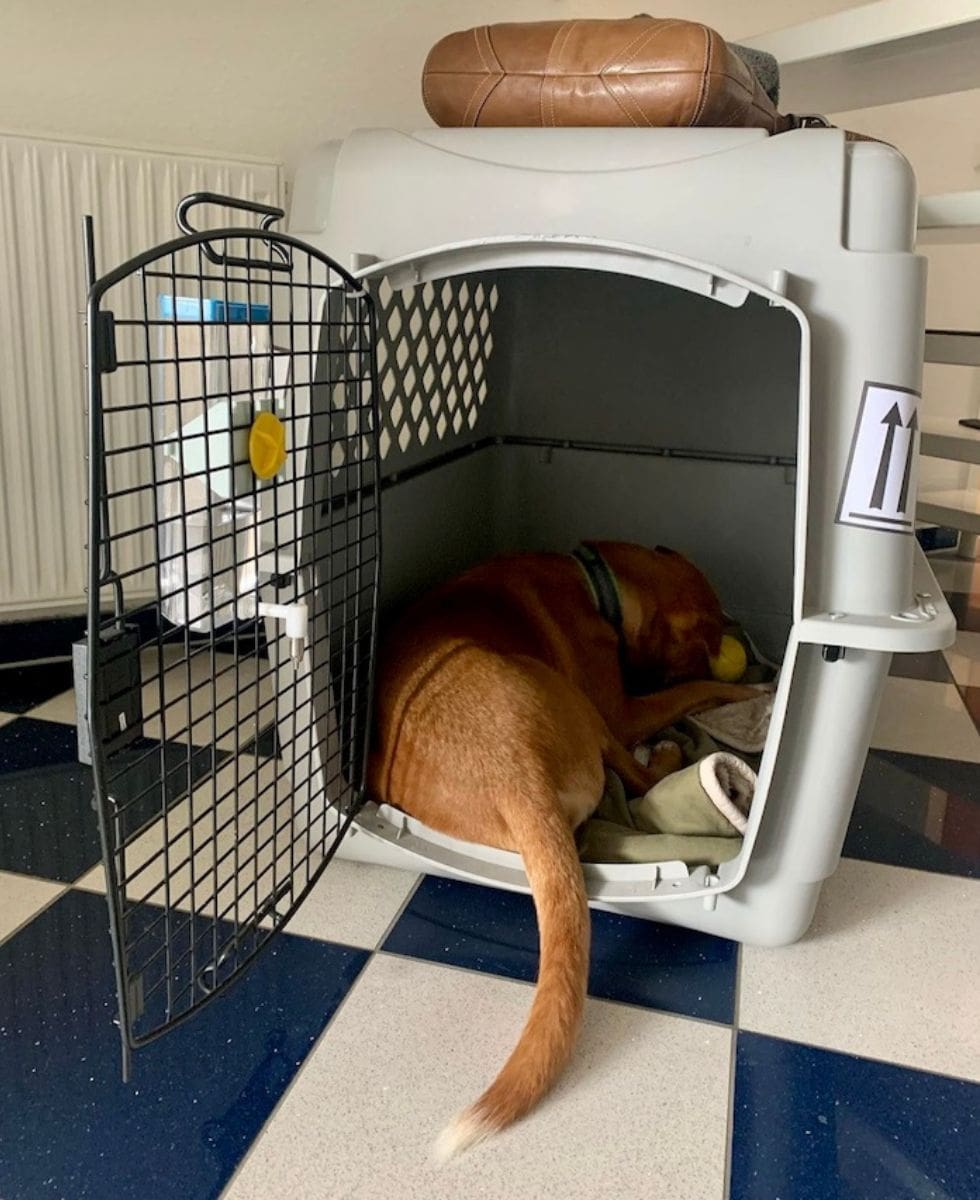
Wally in his travel crate on day 1 at our new place in Germany
6. Comfort and Familiarity
Crate training and designated areas give rescue dogs a sense of comfort and familiarity.
By providing them with their own space that’s filled with their own bedding, toys, and familiar scents, it becomes a place where they can relax and feel at ease.
But remember, crate training should always be done using positive reinforcement techniques.
As you introduce your rescue pup to their new crate, leave the door open and let them explore it at their own pace.
To make it more interesting for them to explore it, you can place their food bowls in there, tasty treats or a favorite toy!
Thankfully, dogs are curious by nature and will eventually want to take a look.
That said, please never use the crate as a form of punishment or confinement for extended periods.
After all, we want our rescue pups to consider the crate a safe space they look forward to hanging out in, and not one they hate.
Establishing A Routine And Providing Consistent Boundaries For Your Rescue Dog
Establishing a routine and providing consistent boundaries are crucial for the successful socialization of rescue dogs.
Here’s why they’re important:
1. Stability and Predictability
Establishing a routine provides rescue dogs with a sense of stability and predictability in their daily lives.
Having consistent feeding times, exercise schedules, and regular activities helps them feel more secure and reduces anxiety.
Since it allows them to anticipate what comes next, it promotes a sense of safety and comfort.
Here’s what Wally’s daily schedule usually looks like:
- 1 hour morning walk
- Breakfast
- Morning nap
- 1 hour midday walk
- Afternoon nap
- 20-30 minute potty break
- Dinner
- Lounging on the couch with his humans
- Playtime
- Last potty break of the day
- Settling in for the night in his crate
When we travel with him by car, which we do 2-3 times per year, this schedule changes a bit, but his breakfast and dinner times remain the same.
2. Clear Boundaries and Expectations
Consistent boundaries set clear expectations for the dog’s behavior and allow the dog to learn appropriate responses and self-control – much like kids need boundaries!
Rescue dogs may have never learned proper rules or boundaries, so providing them with consistent guidelines helps them understand what is acceptable and what is not.
For example, they may have to learn that counter surfing (Wally!), chewing on furniture and scratching up your doors are big no no’s!
On that note, check out our blog post How to stop a dog from chewing on things to learn about strategies that work.
3. Building Trust and Confidence
As I’ve pointed out previously, rescue dogs often need time to develop trust and confidence in their new environment and with their new caregivers.
Consistency in routine and boundaries helps build this trust!
When the pup realizes that:
- Their walking, playing and eating needs are consistently met
- Boundaries are consistently enforced, and
- The environment remains predictable, they begin to feel more secure and confident in their surroundings.
4. Facilitating Training and Learning
A consistent routine and clear boundaries also help with any dog training and overall learning process.
Dogs thrive on consistency and repetition because it makes it easier for them to understand and retain training cues and commands.
So when the dog knows what to expect and receives consistent positive reinforcement for desired behaviors, they can progress more effectively in their training and socialization.
5. Emotional Well-Being
Having a routine and consistent boundaries also positively impacts a rescue dog’s emotional well-being.
That’s because they reduce stress, uncertainty, and confusion.
So by providing structure and predictability, you create an environment that supports their mental and emotional stability.
This contributes to a happier, more balanced, and confident rescue dog.
Gradually Exposing Your Rescue Dog To New Environments
Gradual exposure to new environments and stimuli is a key strategy when you socialize your rescue dog.
This approach involves introducing the dog to unfamiliar:
- Situations
- People
- Animals
- Objects
in a controlled and incremental manner.
The goal is to help the dog develop positive associations and build confidence, which ultimately reduces fear and anxiety.
Here’s how gradual exposure works:
1. Start with Familiar Environments
Begin socialization in a comfortable and familiar setting, such as your home or a quiet outdoor space.
Allow the dog to explore and become accustomed to their immediate surroundings before moving on to more challenging environments.
2. Introduce One Stimulus at a Time
Introduce new stimuli gradually, focusing on one at a time.
This could include new sounds, sights, smells, or experiences.
For example, start with gentle sounds, gradually increasing the level of exposure as the dog becomes more comfortable.
3. Use Desensitization Techniques
Desensitization involves exposing the dog to a stimulus at a low intensity and gradually increasing it over time.
For instance, if the dog is fearful of loud noises, start by playing a recording of a low-volume noise and gradually raise the volume as the dog shows signs of relaxation and comfort.
This can work great as a way of desensitizing your rescue dog to the sound of fireworks or thunder!
You’ll find lots of YouTube videos that play thunder and fireworks sounds to desensitize dogs.
Since Wally is VERY food motivated, I also always give him a dog food puzzle along with the sounds, whether recorded or happening live.
That way, he associates the loud sounds with good things happening.
Our favorite dog food puzzles are:
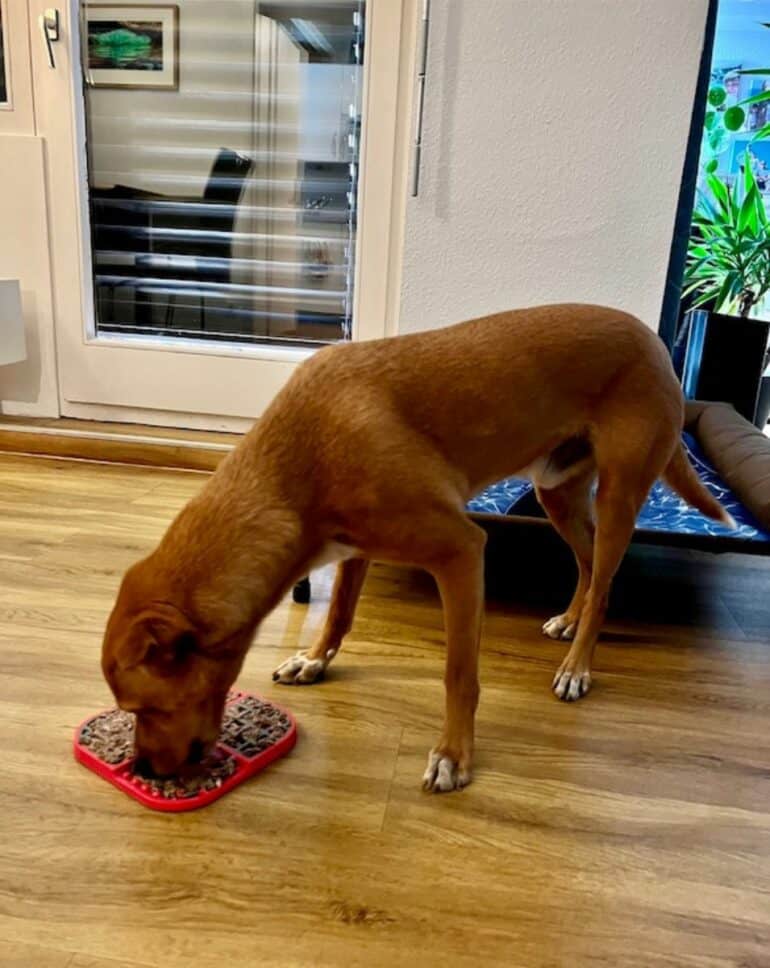
Wally’s frozen LickiMat Slomo features ground raw dog food
4. Positive Reinforcement
During each exposure, use positive reinforcement techniques to reward the dog for calm and confident behavior.
Offer yummy treats, verbal praise, or play as a reward for being brave pups!
This helps create positive associations with the new environments or stimuli and reinforces the desirable behavior of staying calm.
5. Monitor Body Language
When you introduce your pup to new stimuli, pay close attention to their body language throughout the process.
Signs of stress or anxiety indicate that you may need to slow down or adjust the intensity of the exposure.
For example:
- Trembling
- Panting
- Salivating
- Avoidance
Remember, every dog is unique, so respect their comfort zone and progress at their individual pace.
6. Gradually Increase Difficulty
As the dog becomes more comfortable with each exposure, gradually increase the level of difficulty.
Introduce new environments, novel experiences, and interactions with unfamiliar people or animals.
With Wally, I took him to dog-friendly shops like pet retail stores when they weren’t super busy.
He got to say hi to the staff, usually got a free treat, and we practiced a few obedience commands as we were walking down the different aisles.
For my clients’ rescue Beagles, they got to see me on a Monday-Friday basis when I came for their daily midday visits.
Unless they were being treated for heartworms or other medical issues, they also went to dog adoption events after a few weeks, where they obviously met more people and other dogs.
7. Optional: Seek Professional Guidance
If you encounter significant challenges or if your rescue pup displays severe fear or aggression, you should seek guidance from a professional dog trainer or behaviorist experienced in working with rescue dogs.
They can provide expert advice and support tailored to the specific needs of your dog.
Remember, the key to successful gradual exposure is patience and understanding.
Each dog progresses at their own pace, and it’s essential to respect their individual needs and comfort levels.
Positive Reinforcement Training To Help Socialize A Rescue Dog
Positive reinforcement training methods are highly effective for socializing rescue dogs.
These methods focus on rewarding desirable behaviors rather than punishing undesirable ones.
Here’s why positive reinforcement training is beneficial to socialize a rescue dog:
1. It Builds Trust and Confidence
Positive reinforcement training establishes a bond of trust between the dog and their owner as they learn to rely on their new human as a source of rewards.
By using food, toys and verbal rewards, the dog learns to associate social interactions and new experiences with positive outcomes, which helps build their confidence.
2. It Encourages Desired Behavior
Positive reinforcement training focuses on rewarding and reinforcing desired behaviors.
When a rescue dog displays appropriate social behaviors such as calmness, friendliness, or proper manners, they receive the rewards.
This encourages them to repeat those behaviors.
3. It Reduces Fear and Anxiety
As we’ve already established, rescue dogs may have fear or anxiety due to past experiences.
Positive reinforcement training provides a positive and supportive environment that helps alleviate their fears.
By focusing on rewards and positive associations, the dog learns to associate socialization with pleasant experiences, which reduces anxiety and fear responses.
4. It Enables Effective Communication
Positive reinforcement training allows for clear and effective communication between the owner and the rescue dog.
By rewarding desired behaviors, the dog understands what is expected of them.
5. It Promotes Emotional Well-Being
Positive reinforcement training promotes the emotional well-being of rescue dogs.
That’s because it creates a positive and nurturing environment where the dog feels safe, loved, and valued.
Basic Obedience Training & Key Commands For Rescue Dogs
When it comes to basic obedience training and teaching key commands to a rescue dog, here are some tips to help you:
1. Start With The Basics
Begin by focusing on essential commands such as “sit,” “stay,” “down,” and “come.”
These commands lay the foundation for good behavior and safety.
You can read more about how to teach them (and others!) in our blog post 21 Dog Training Commands.
2. Remember To Use Positive Reinforcement
I’ve already pointed this out a few times, but I’ll say it again:
Positive reinforcement is key.
Reward your dog with yummy treats, verbal praise, or play and toys whenever they exhibit the desired behavior or respond correctly to a command.
This encourages them to repeat the behavior and strengthens the learning process.
3. Keep Training Sessions Short and Positive
Keep training sessions short, around 10-15 minutes, to maintain the dog’s attention and prevent them from becoming overwhelmed.
Make training a positive experience by incorporating play and treats, and always end on a positive note.
If you’re still old school and watch regular TV, you can use the commercial breaks for short training sessions!
4. Be Consistent
Consistency is crucial in (rescue) dog training.
Use the same commands and hand signals consistently, and ensure everyone in the household follows the same training methods and cues.
That includes your spouse, kids, dog walkers and pet sitters.
This helps avoid confusion and reinforces the dog’s understanding of the commands.
5. Practice in Different Environments
Gradually introduce training sessions in various environments to help your rescue dog generalize commands.
Start in a quiet and familiar space, then gradually add distractions and practice outdoors or in public areas.
This helps the dog learn to respond to commands in different contexts.
Obviously, difficult commands like the “come” command are going to be more challenging in the distracting outdoors than inside your home, but one good way of practicing them outside is on a long leash!
6. Break Commands into Steps
For complex commands like the “Count command”, break them down into smaller, manageable steps.
Teach each step individually and gradually combine them – we also share how to teach this particular command in our blog post 21 Dog Training Commands!
This incremental approach helps your pup understand and succeed in learning the full command.
7. Stay Positive
Above all else, approach training with a positive mindset!
Dogs pick up on our energy, so maintain a calm and positive demeanor during training sessions.
This creates a conducive environment for learning and helps your rescue dog feel comfortable and motivated.
Remember, each dog is unique, and the time it takes for them to learn commands may vary.
So be patient, consistent, and always focus on positive reinforcement.
This strengthens the human-animal bond and fosters a sense of security.
Examples Of Activities To Help Socialize Your Rescue Dog
To help socialize a rescue dog, here are some activities to consider doing with your pup:
1. Supervised Playdates
Arrange supervised playdates with well-behaved and friendly dogs.
Start with dogs that have a calm and gentle temperament, and gradually introduce more energetic or playful dogs as your rescue dog becomes more comfortable.
Supervision ensures safety and allows for positive interactions, promoting socialization and building confidence.
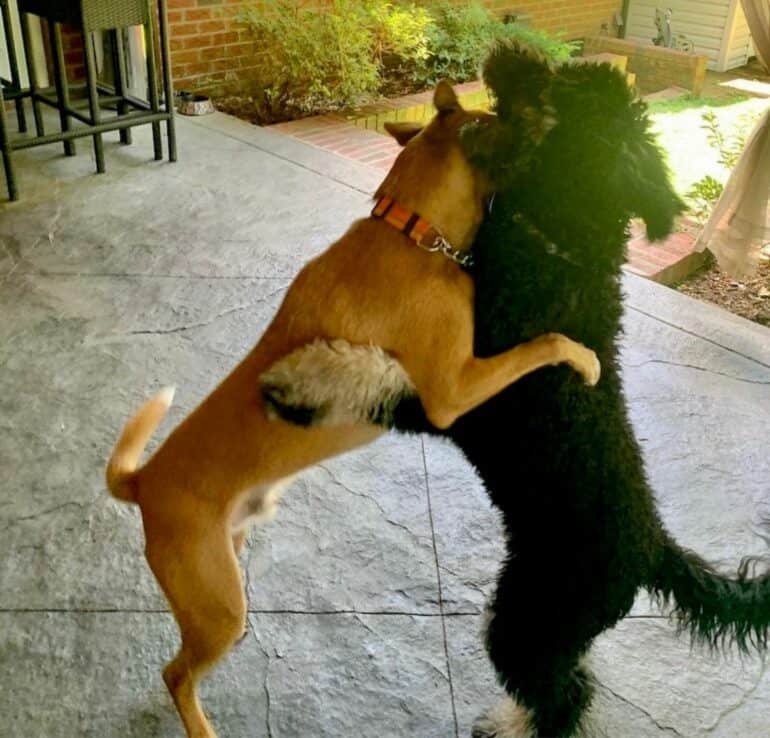
Wally on a playdate with his Labradoodle friend Rory
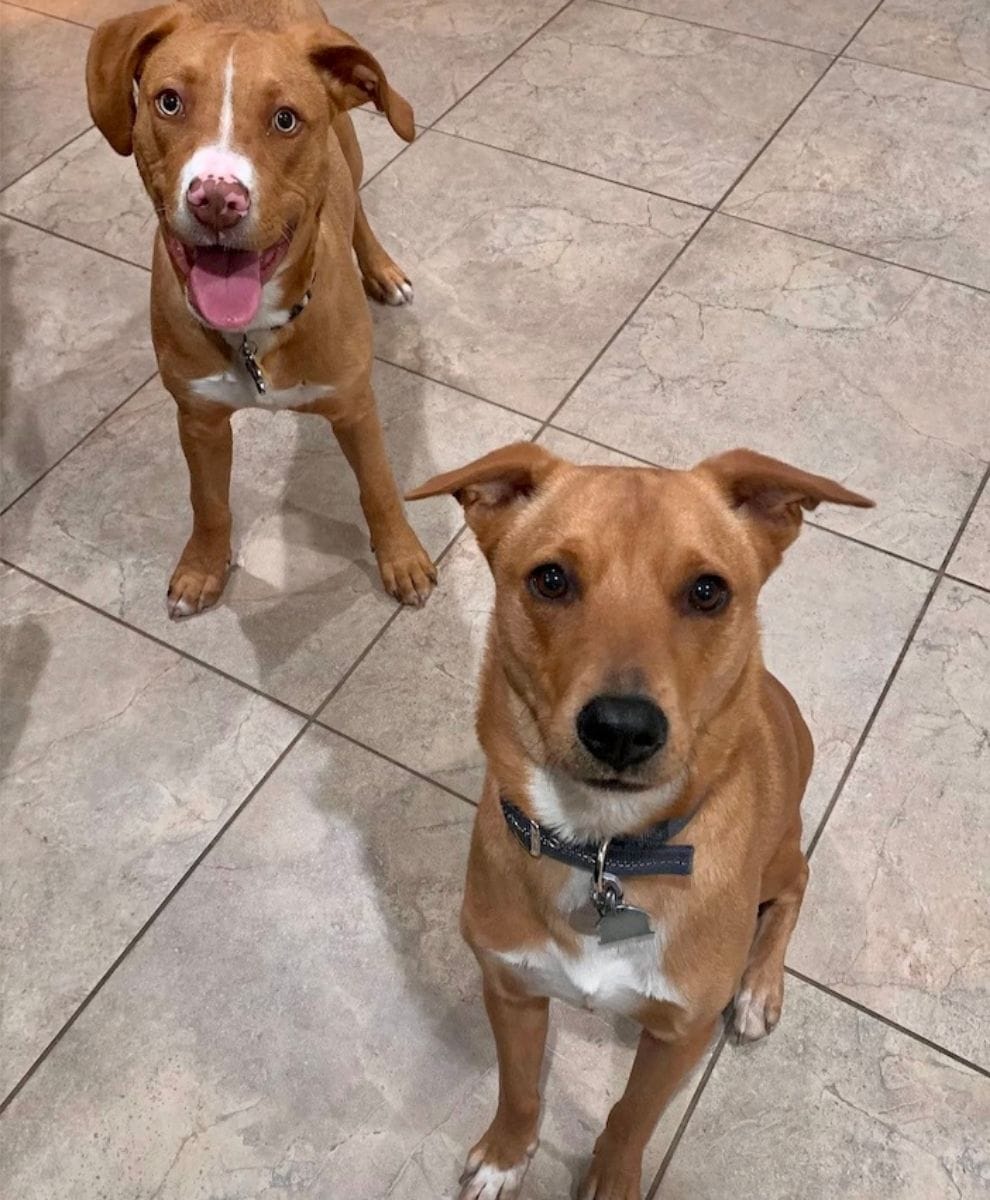
Wally socializing with his puppy friend Fonzie
2. Training Classes
Enroll your rescue dog in training classes, such as obedience or agility classes, specifically designed for socialization.
These classes provide structured environments where your dog can learn to follow commands, interact with other dogs, and practice good manners.
Professional trainers can offer guidance and support, ensuring the classes are positive and productive for your dog’s socialization journey.
3. Group Dog Walks
Join organized group walks or dog walking groups in your community.
These outings allow your rescue dog to interact with other dogs and their owners in a controlled and supervised setting.
Walking together in a group provides opportunities for positive social interactions, exposure to different environments, and practicing good leash manners.
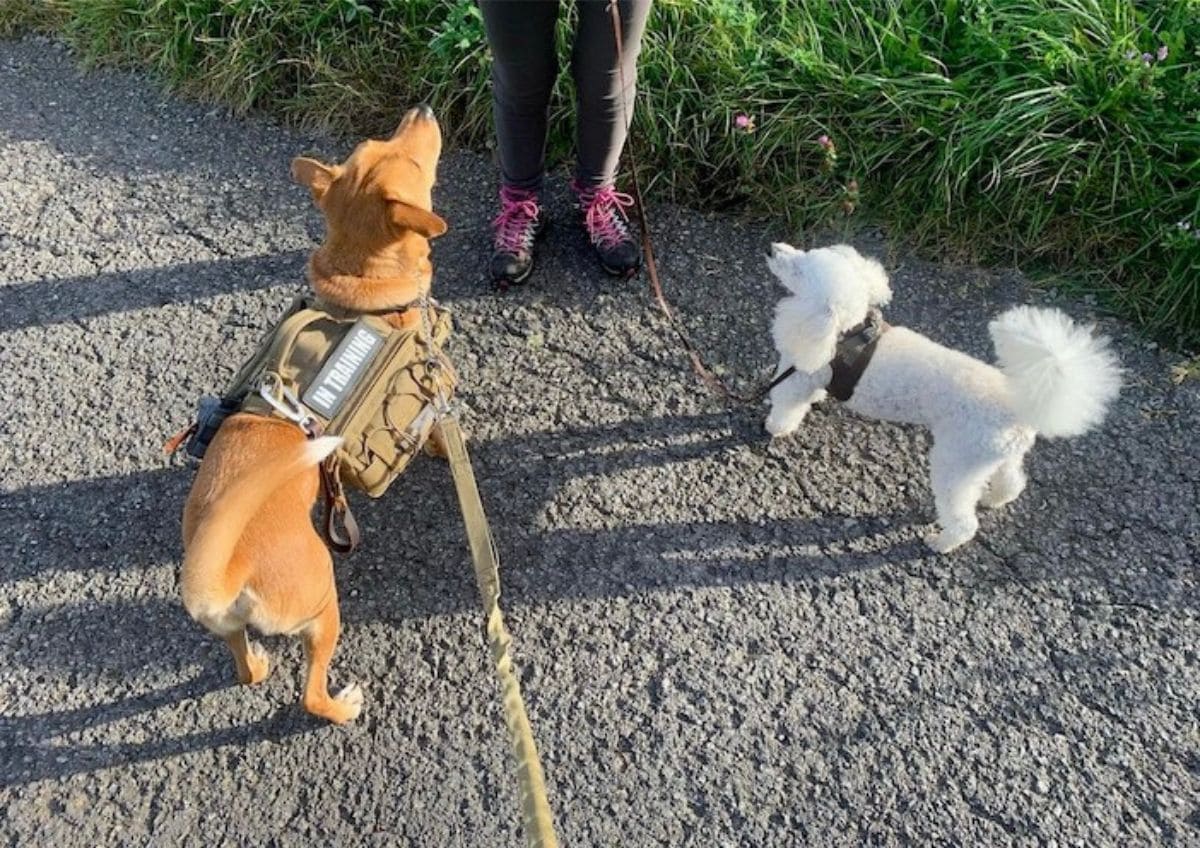
Wally out on a backpack walk with his doggie friend Orlando
4. Meetups and Socialization Events
Look for dog meetup groups or socialization events in your area.
These gatherings bring together dog owners and their pets for socialization and play.
It’s a chance for your rescue dog to meet new dogs and people in a supportive and structured environment, promoting positive interactions and building confidence.
5. Controlled Exposures
Gradually expose your rescue dog to various environments, stimuli, and experiences in a controlled manner.
This can include outings to pet-friendly stores, outdoor cafes with dog-friendly patios, or quiet public spaces.
Ensure your dog is comfortable and not overwhelmed, and use positive reinforcement to create positive associations with these new experiences.
6. A Word On Dog Parks
While dog parks can provide valuable opportunities for your rescue dog to interact with other dogs and people in a controlled and monitored environment, I personally am not a huge fan of them.
That’s because you never know who’s going to be there and how well-behaved (or misbehaved!) other dogs are.
So if you do want to give dog parks a try, I suggest that you begin by visiting during quieter times. That’s when there’ll only be a handful of dogs that are going to be much easier to control than a large pack of dogs.
Always follow the rules of the park and closely observe your pup’s behavior to ensure they are comfortable and enjoying the experience.
Remember to always prioritize your rescue dog’s safety, well-being, and comfort during these activities.
Observe their body language and reactions, and make adjustments as needed.
Every dog is unique, so tailor the activities to your dog’s individual needs and preferences.
With patience, consistency, and positive experiences, you can help your rescue dog develop valuable social skills and thrive in various social settings.
A Rescue Story Gone Wrong
I can’t help but share the story of a rescue puppy that one of my clients adopted.
Let’s call her Fate (I changed the name).
Fate was a medium-size mutt puppy who was pulled from a kill shelter when she was about 5 months old.
The client ended up adopting her but unfortunately, they barely implemented any of the strategies I just shared.
Fate moved in with the family and their other pets and got along fine with all of them.
She got her own crate but spent way too much time in there given how much energy she had.
While she had access to a large property, she was often outside unsupervised and wasn’t introduced to any rules or offered structure.
That said, she ended up biting one too many delivery people who accessed the property, one of whom ended up pressing charges.
This resulted in Fate being put down.
Big sigh.
The pup was a sweet dog and could have been a wonderful companion dog IF she had been provided rules and structure, training, and proper exercise.
Instead, she was left to her own devices and found ways to keep herself busy.
This is obviously not what should have happened, but it did.
So as a general reminder, please DO plan to spend time with any rescue dogs you adopt and help them on their journey to becoming a polite dog.
If you don’t feel like you can take time out of your busy schedules, then don’t adopt a rescue dog.
Bottom Line
It takes a lot of time, energy and patience to socialize a rescue dog, and if you’ve made it this far, you should have a good idea of how to go about it!
The main goal in socializing rescue dogs is to expose them to various people, animals, environments, and stimuli in a controlled and positive manner.
Overall, socialization is crucial for rescue dogs to help them overcome their past experiences, become well-adjusted members of their new families, and lead happier, more fulfilling lives.
With patience and positive reinforcement, you can create an environment that fosters the growth and social integration of rescue dogs.
But remember that socialization is a continuous process, and setbacks may occur along the way!
If you feel like you can’t manage a specific behavior effectively on your own, don’t hesitate to seek guidance from dog trainers and/or behaviorists experienced in working with rescue dogs.
Let’s all try to avoid situations that end up badly like they did for Fate.
Now it’s your turn – do you have any additional tips on how to socialize a rescue dog?
We’d love to read them in the comment section below this blog post!
Save To Pinterest
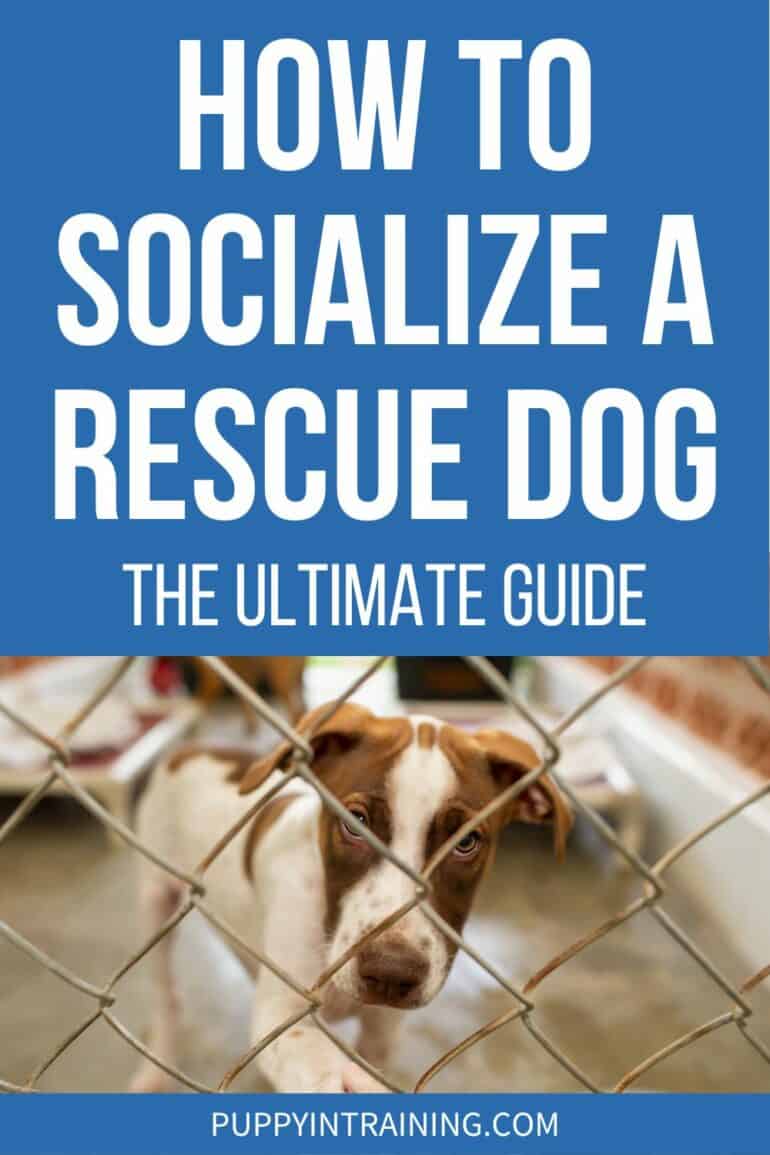
Top Picks For Our Puppies
- BEST PUPPY TOY
We Like: Calmeroos Puppy Toy w/ Heartbeat and Heat Packs – Perfect for new puppies. Helps ease anxiety in their new home. - BEST DOG CHEW
We Like: Mighty Paw Naturals Bully Sticks – All of our puppies love to bite, nip, and chew. We love using Bully Sticks to help divert these unwanted behaviors. - BEST DOG TREATS
We Like: Crazy Dog Train-Me Treats – We use these as our high-value treats for our guide dog puppies. - BEST FRESH DOG FOOD
We Like: The Farmer’s Dog – A couple months ago we started feeding Raven fresh dog food and she loves it! Get 50% off your first order of The Farmer’s Dog.
Check out more of our favorites on our New Puppy Checklist.


